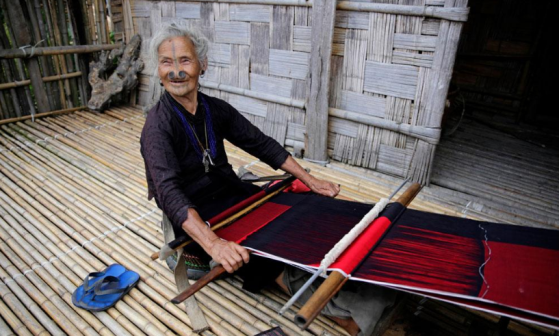Description

Disclaimer: Copyright infringement not intended
Context
- An application seeking Geographical Indication (GI) tag for the Arunachal Pradesh Apatani textile product has been filed.
Apatani weave
- The Apatani weave comes from the Apatani tribe of Arunachal Pradesh living at Ziro.
- The woven fabric of this tribe is known for its geometric and zigzag patterns and also for its angular designs.
- The Apatani community weaves its own textiles for various occasions, including rituals and cultural festivals.
- The tribe predominantly weaves shawls known as jig-jiro and jilan or jackets called supuntarii.
- The people here use different leaves and plant resources for organic dying the cotton yarns in their traditional ways. And only women folk are engaged in weaving.
Handloom
- The traditional handloom of this tribe is a type of loin loom, which is called Chichin, and is similar to the traditional handloom of the Nyishi tribe.
- It is portable, easy to install and operated by a single weaver, especially the female member of the community.
About Apatani Tribe
- The Apatani, or (Tanw, Tanii) are a tribal group of people living in the Ziro valley in the Lower Subansiri district of Arunachal Pradesh.
- The Apatanis, have a distinct civilization with systematic land-use practices and rich traditional ecological knowledge of natural resources management and conservation, acquired over the centuries.
- Their wet rice cultivation system and their agriculture system are extensive even without the use of any farm animals or machines. So is their sustainable social forestry system.
- UNESCO has proposed the Apatani valley for inclusion as a World Heritage Site for its "extremely high productivity" and "unique" way of preserving the ecology.
- Major festivals – Dree and Myoko.
- In July, the agricultural festival of Dree is celebrated with prayers for a bumper harvest and prosperity of all humankind.
- Paku-Itu, Daminda, Piree dance, etc., are the main cultural programmes performed in the festival.
GI Tag
- A geographical indication or GI is a sign used on products that have a specific geographical origin and possess qualities or a reputation that are due to that origin.
- Geographical Indications are part of the intellectual property rights that comes under the Paris Convention for the Protection of Industrial Property.
- In India, Geographical Indications registration is administered by the Geographical Indications of Goods (Registration and Protection) Act of 1999.
- This tag is valid for a period of 10 years following which it can be renewed.
- GI tags are covered under World Trade Organization.
- Geographical indications are typically used for agricultural products, foodstuffs, wine and spirit drinks, handicrafts, and industrial products.
- It is basically an assurance that the product is coming from that specific area.
- It's kind of trademark in the international market.
- Karnataka has the highest number of GI tagse. 47products followed by Tamil Nadu (39).
Benefits of registration of Geographical Indications
- It confers legal protection to Geographical Indications in India
- Prevents unauthorised use of a Registered Geographical Indication by others
- It provides legal protection to Indian Geographical Indications which in turn boost exports.
- It promotes economic prosperity of producers of goods produced in a geographical territory.
How a geographical indication is different from a trade mark?
- A trade mark is a sign which is used in the course of trade and it distinguishes goods or services of one enterprise from those of other enterprises.
- Whereas a geographical indication is an indication used to identify goods having special characteristics originating from a definite geographical territory.
To read about to complete list of GI Tags,
Visit: https://www.iasgyan.in/blogs/complete-list-of-geographical-indications-gi-tags-in-india-as-of-2021
https://www.thehindu.com/news/national/other-states/plea-seeks-gi-tag-for-arunachal-apatani-textile-product/article38059215.ece








